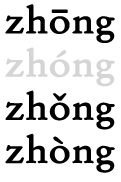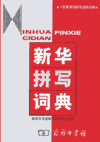I’m back from abroad now and starting to catch up on this and that. So here’s another post for you Mac users.
QIM, a popular pinyin-based Hanzi-input method, has become freeware. It was formerly US$20.

I’m back from abroad now and starting to catch up on this and that. So here’s another post for you Mac users.
QIM, a popular pinyin-based Hanzi-input method, has become freeware. It was formerly US$20.
Those of you who, unlike me, own an iPhone, an iPad, or an iPod Touch may find the new Pinyin Typist Mac application of use.
Taffy of Tailingua had a look at this for me.
I’ve had a play with the Pinyin application and I’m generally quite positive about it. It’s clean, unfussy, and gets the job done. The automatic positioning looks to be flawless (i.e. typing zhuang1 gives you zhu?ng, not zh?ang)…. Overall though I like it, as it does what it set out to do without any showboating or unnecessary steps (excepting apostrophes).
Although I wish the apostrophe and hyphen were right there on the main screen instead of on a secondary one, the program allows people to do what they need to do: type Pinyin with tone marks.
[Headline changed from “Mac app for writing Pinyin with tone marks”]
 My previous post mentioned that not all tonal permutations exist in the real world. For example, modern standard Mandarin has zhōng, zhǒng, and zhòng, but doesn’t have zhóng. I did not, however, get into any of the reasons for the absence of second-tone zhong.
My previous post mentioned that not all tonal permutations exist in the real world. For example, modern standard Mandarin has zhōng, zhǒng, and zhòng, but doesn’t have zhóng. I did not, however, get into any of the reasons for the absence of second-tone zhong.
Fortunately, my friend James E. Dew, who is much more qualified than I to discuss such fine points of linguistics, was kind enough to send in the explanation below. Jim used to teach the Chinese language and linguistics at the University of Michigan; and for many years he directed the Inter-University Program (a.k.a. the Stanford Center) in Taipei. He is also the author of 6000 Chinese Words: A Vocabulary Frequency Handbook and coauthor of Classical Chinese: A Functional Approach.
Most simply stated, Mandarin syllable shapes with unaspirated occlusive initials and nasal finals don’t occur in second tone. This can be restated a bit less opaquely for those who have not studied Chinese historical phonology, as follows:
Syllables that begin with unaspirated stops b, d, g, or affricates j, zh, z, and end in a nasal n or ng, as a rule don’t have second-tone forms. There are a few exceptions, such as béng (甭 / “needn’t”) and zán (咱 / “we”), which were new words formed by contraction — from búyòng and zámén, respectively — after the tone class split described below took place.
This came about because when Middle Chinese (of Sui-Tang times) píngshēng 平声/平聲 split into yīnpíng 阴平/陰平 (modern Mandarin “first tone”) and yángpíng 阳平/陽平 (M “second tone”), syllables with aspirated initials went into the new yángpíng class, while those with unaspirated initials all fell into the yīnpíng (M first tone) group, thus leaving no unaspirated syllables with nasal finals in the modern Mandarin second tone class.
An interesting corollary to this rule is that among Mandarin “open” syllables (those that end in a vowel) with the above-listed initials, almost all of the second-tone syllables derive from Middle Chinese rùshēng 入声/入聲, and their cognates have stop endings in the southern dialects that preserve rùshēng, as illustrated by the Cantonese examples given below.
| Mandarin | Cantonese | |
|---|---|---|
| 拔 | bá | baht |
| 白 | bái | baahk |
| 薄 | báo | bohk |
| 別/别 | bié | biht |
| 伯 | bó | baak |
| 博 | bó | bok |
| 答 | dá | daap |
| 德 | dé | dāk |
| 敵/敌 | dí | dihk |
| 毒 | dú | duhk |
| 格 | gé | gaak |
| 閣/阁 | gé | gok |
| 國/国 | guó | gwok |
| 急 | jí | gāp |
| 極/极 | jí | gihk |
| 集 | jí | jaahp |
| 夾/夹 | jiá | gaap |
| 結/结 | jié | git |
| 節/节 | jié | jit |
| 菊 | jú | gūk |
| 覺/觉 | jué | gok |
| 決/决 | jué | kyut |
| 雜/杂 | zá | jaahp |
| 澤/泽 | zé | jaahk |
| 閘/闸 | zhá | jaahp |
| 宅 | zhái | jaahk |
| 哲 | zhé | jit |
| 執/执 | zhí | jāp |
| 直 | zhí | jihk |
| 竹 | zhú | jūk |
| 濁/浊 | zhuó | juhk |
As most people reading this blog know, Mandarin has about 1,300 syllables (interjections and loan words complicate the count a little). If tones — a basic part of the language — are disregarded, the number of drops to 400 and something syllables.
Given 410 or so basic syllables and 4 tones — one of these days I need to write something more on the wrongful neglect of the so-called neutral tone — some people might expect there to be more like 1,640 syllables instead of about 1,300. The reason for the lower number is that not all syllables exist in all four tones. For example, quite clearly the official language of Zhōngguó does not lack zhōng … or zhǒng or zhòng. But zhóng is another matter.
So not all possible tonal variations of those 400-something syllables appear in modern standard Mandarin. But what about letters?
If you look at the official alphabet for Hanyu Pinyin, it’s exactly the same as that for English (other than in pronunciation, of course), which is a bit odd, especially considering that Pinyin doesn’t use the letter v (or at least isn’t supposed to for Mandarin words).
So in this case, I’m excluding v but otherwise being expansionist about the glyphs I’m calling letters. To be specific: I’m referring to a-z, minus v, but including ā, á, ǎ, à, ē, é, ě, è, ī, í, ǐ, ì, ō, ó, ǒ, ò, ū, ú, ǔ, ù, ü, ǖ, ǘ, ǚ, and ǜ. (Even though Ī, Í, Ǐ, Ì, Ū, Ú, Ǔ, Ù, Ü, Ǖ, Ǘ, Ǚ, and Ǜ never come at the beginning of a word, let’s not automatically eliminate them, because there is an occasional need for ALL CAPS.)
Are there any of those possible glyphs that don’t appear at all — at least as given in the large ABC Comprehensive Chinese-English Dictionary?
The answer, perhaps surprisingly, is yes.
Which letter is it?
Have you made your choice?
It doesn’t take much thought to eliminate C as the answer. “Nǚ” (woman) is one of those first-couple-of-Mandarin-lessons vocabulary terms. And the word for green (lǜsè) is hardly obscure either. It might be harder to think of a word with the letter ǘ; but there are some. Donkey (lǘ) is probably the most common. So the answer is A: ǖ.
It’s important to note that the lack of ǖ is in appearance only. The sound ǖ occurs in plenty of Mandarin words; it’s just that Pinyin’s simplified orthography calls for writing “u” instead where ǖ follows j, q, x, or y.
But even though I didn’t find an example of ǖ, I’d encourage font designers not to scratch it from their list of must-have glyphs for Pinyin faces, especially since teachers will no doubt want to continue giving tone-pattern drills based on four tones for all vowels, regardless. Also, someone with a searchable edition of the Hanyu Da Cidian or maybe the new Oxford online edition is probably about to use the comments to point me to some obscure entry there….
 Today’s selection from Yin Binyong’s Xīnhuá Pīnxiě Cídiǎn (《新华拼写词典》 / 《新華拼寫詞典》) deals with how to write Mandarin’s various de‘s, mood particles, and interjections.
Today’s selection from Yin Binyong’s Xīnhuá Pīnxiě Cídiǎn (《新华拼写词典》 / 《新華拼寫詞典》) deals with how to write Mandarin’s various de‘s, mood particles, and interjections.
This reading is available in two versions:
I’ve already written about the principles in previous posts. For example, see
 Today’s selection from Yin Binyong’s Xīnhuá Pīnxiě Cídiǎn (《新华拼写词典》 / 《新華拼寫詞典》) is about writing numbers and measure words.
Today’s selection from Yin Binyong’s Xīnhuá Pīnxiě Cídiǎn (《新华拼写词典》 / 《新華拼寫詞典》) is about writing numbers and measure words.
This reading is available in two versions:
For more on this, see these posts and the PDFs linked to therein.

Here’s the first of several selected readings from Yin Binyong’s Xīnhuá Pīnxiě Cídiǎn (《新华拼写词典》 / 《新華拼寫詞典》). It covers the writing of verbs.
This reading is available in two versions:
For those who would like to read about this in English, see
 Xīnhuá Pīnxiě Cídiǎn (《新华拼写词典》 / 《新華拼寫詞典》), is the second of Yin Binyong’s two books on Pinyin orthography. The first, Chinese Romanization: Pronunciation and Orthography, is in English and Mandarin; much of it is already available here on Pinyin.Info.
Xīnhuá Pīnxiě Cídiǎn (《新华拼写词典》 / 《新華拼寫詞典》), is the second of Yin Binyong’s two books on Pinyin orthography. The first, Chinese Romanization: Pronunciation and Orthography, is in English and Mandarin; much of it is already available here on Pinyin.Info.
Although Xinhua Pinxie Cidian is only in Mandarin, the large number of examples makes it easy to get the point even if you may not read Mandarin in Chinese characters very well.
This week I will begin posting some excerpts from this invaluable work. What’s more, I have made a version in traditional Chinese characters, which I hope that readers in Taiwan, Hong Kong, and elsewhere will take advantage of. So those not used to reading simplified Chinese characters will have a choice (which is more than the government of Taiwan is providing these days).
I’m extremely happy to be able to bring you this information and wish to acknowledge the generosity of the Commercial Press. Stay tuned.